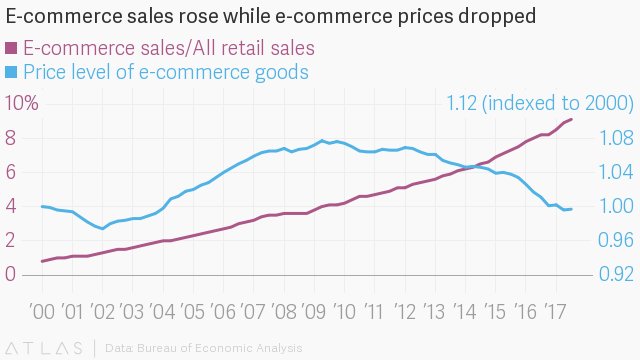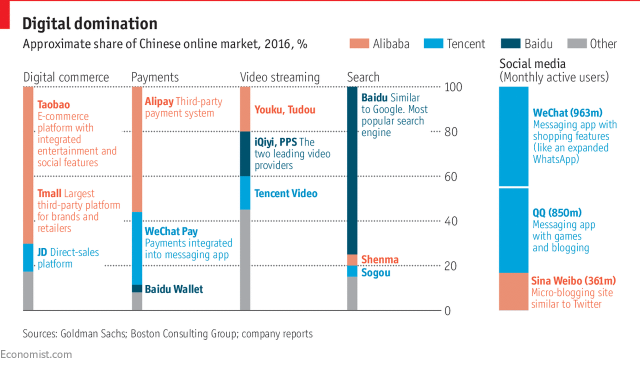The above chart from Quartz shows how much e-commerce sales in the US have grown because of the low price. In fact, the price level is now comparable to 2000 prices. In short, many goods on e-commerce are being sold on very marginal and progressively diminishing profits.
Leave a CommentPoiesis Posts
Wired Magazine reports that San Francisco is planning to adjust parking spot prices based on demand, essentially moving to dynamic pricing of parking spots. Note that SF has been experimenting with the dynamic pricing of spots already. This proposal by San Francisco Municipal Transportation Agency (SFMTA) — which has not been voted by the City Council yet — expands the dynamic pricing spots from the current 7000 meters to 28,000 meters. I’ll make 4 salient points about the issue: (a) Success depends on operational transparency, (b) Roads utilization, not spots, is the main source of congestion, (c) Dynamic pricing may not improve utilization, and (d) Dynamic pricing may hurt consumer welfare. (In fact, I will discuss research evidence that SFPark…
Leave a CommentThe Hudsucker Proxy is my second favorite Coen brothers movie on rewatchability.1 Within their oeuvre, The Hudsucker Proxy is closest to capturing the humor in American manufacturing/business culture (exceeded only by William H. Macy’s exasperated car salesman role in Fargo). While talking about Dynamic pricing in class, I typically refer to the funny story in Hudsucker Proxy, which has a retailer (ostensibly, all retailers) adjusting the price of HulaHoops in the light of the increased demand. Here is the embedded video from the movie that shows the design of the product, progression into the production process, and testing, leading to its retail sales — the lifecycle of hope, demise, and rebirth of a product. The movie also features Jennifer Jason…
Leave a CommentOnline Sales in China exceeded USD 366B in 2016, almost comparable to e-commerce sales in the United States (360B in 2016). Note that online retail is “only” about 8.5% of the overall retail market in the United States. According to Fortune Magazine, Amazon was 34% of the US e-commerce market. However, China is an entirely different story. Amazon barely makes an appearance among the big e-commerce contenders. Taobao – an e-Bay like electronic market place owned by Alibaba commands a lion’s share of the China e-commerce market. Perhaps, even more, impressive is the scale of vertical integration of mobile payment systems with their corresponding e-commerce websites. For instance, the largest third-party payment system, Alipay, the mobile payment arm of Alibaba, has…
Leave a CommentWhere do temporary e-commerce workers come from? I noticed that Jessica Bruder’s Nomadland, a book I enjoyed reading earlier in November, was listed in the NYTimes 100 Notable Non-Fiction books of 2017. Well-deserved recognition for the book. I recommend the book review by the sociologist Arlie Hochschild, who has written several deeply informative books on the nature of work and life in America. Here is an excerpt from Dr. Hochschild’s review. Moving “like blood cells through the veins of the country,” Jessica Bruder writes, a growing number of older people, post-recession refugees from the middle and working class, are, like Linda, crossing the land in their Jeeps, campers and repurposed buses in search of work. … Other nomads “pick raspberries in Vermont, apples in…
Leave a CommentI always thought that the term Black Friday, originated when retail firms turned “red” to “black”. Due to the heavy seasonality in sales, the existence of this term always made sense, especially for Retail firms. Through Kevin Drum at Mother Jones, I learned that history is more complicated. But, most interesting for the readers of this blog: The term originated in Philadelphia, probably sometime in the 50s, and wasn’t in common use in the rest of the country until decades later. From Wanamaker’s Department Stores to trying to Amazon HQ2 to Philly, Retail has changed a lot here.
Leave a Comment[A deviation from usual Operations Posts]. Star Wars is easily the second biggest cultural export of the United States. (Disney is No 1. So it seems natural that Disney eventually acquired the rights to Star Wars). Parents often want to share the excitement of the mythology of Star Wars with young kids. This is not easy for those who lived through the nostalgia of the 80s that was nearly corrupted by the tragedies of the 90s prequels. Such parents often ponder the following question: In what order do I introduce Star Wars to my kids? The following advice follows from my experience. (Caveat: I don’t claim to be the biggest fan of Star Wars, and the following idea is definitely…
Leave a Comment

